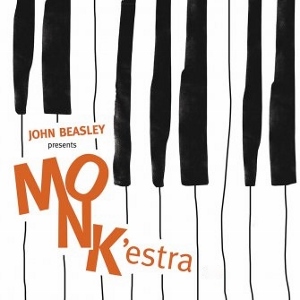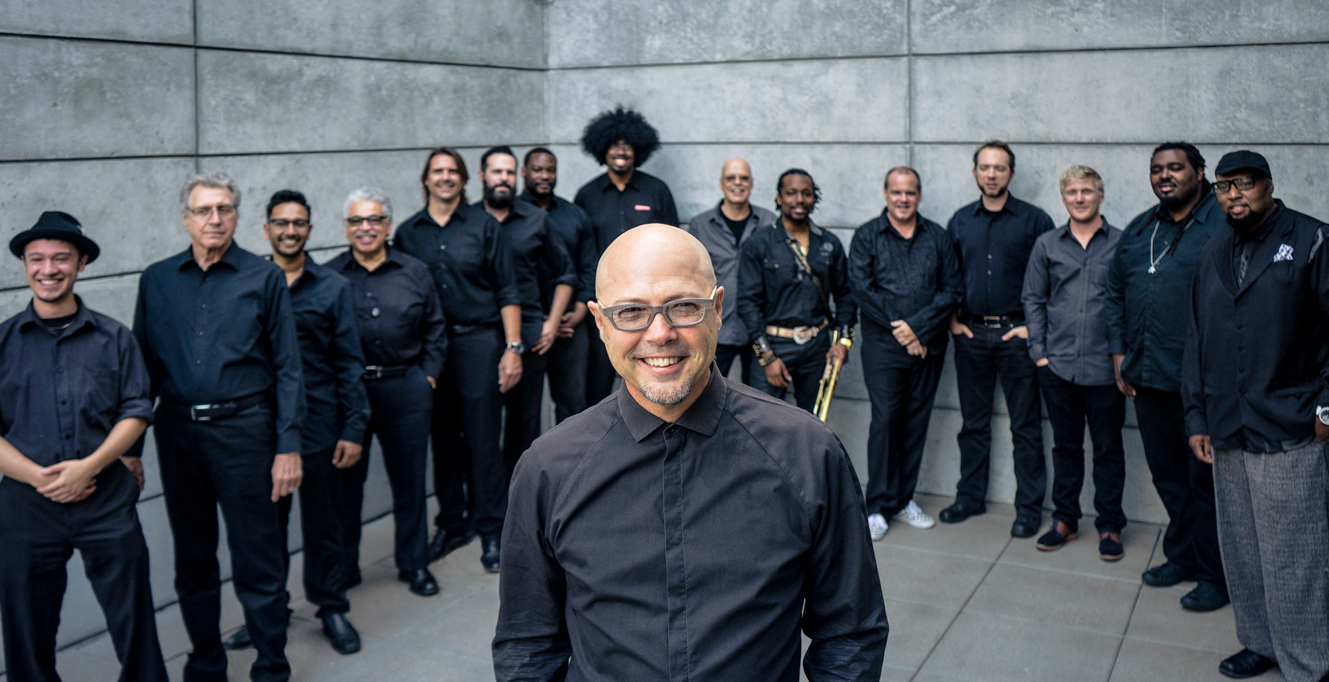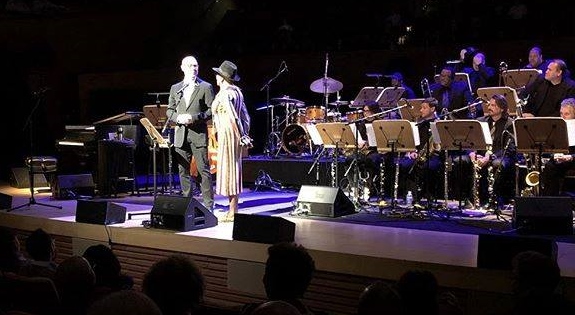THE MAGICAL MONK LEFT HIS MARK
Just when I thought nothing could touch Jason Moran’s recreation of Thelonious Monk’s 1959 Town Hall recording last November, along comes the great John Beasley with his take on the great jazz inventor. Beasley wasn’t trying to recreate Monk at Disney Hall last night; instead, he has come up with themes and variations while enlarging Monk, creating fresh arrangements that — seasoned with modern elements from hip-hop to Afro-Cuban rhythms, fusion and more — always shifted and surprised. You know how I know it’s great? Well, to quote Monk: “Know it when you hear it.” The effect was at once invigorating and soothing. But above all, it was so magical and so transcendent as to be at a loss for words to describe it. (There’s a quote attributed to Monk: “Writing about music is like dancing about architecture”; Yeah, tell me about it!)
It’s a totally successful new sound based on an old sound that really worked up the jazz devotees in attendance. What we got was some of the best in the biz re-imagining Monk’s body of work — a contemporary look at Thelonious Sphere Monk (his real name) with cool arrangements and brilliant execution by conductor/arranger/pianist Beasley and his 16-member big band, named 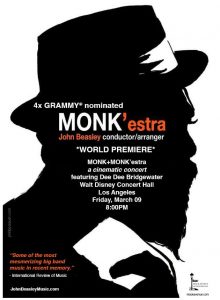 MONK’estra, which stopped in L.A. as part of a global tour that kicked off last year in Pyeongchang, South Korea.
MONK’estra, which stopped in L.A. as part of a global tour that kicked off last year in Pyeongchang, South Korea.
But this is a whole new show. Culled from two documentaries — Michael and Christian Blackwood’s Monk and Monk in Europe — were clips of Monk performing at the Village Vanguard, at a recording session (and elsewhere), strolling down the streets of New York, and traveling — all exactly fifty years ago in 1968. Projected on a screen above the stage, these delicious sequences were edited and incorporated into the music (by Beasley, filmmaker Stefan Forbes and music editor Bill Bernstein) so that Monk himself — sweating with a lit cigarette dangling from his mouth — was actually playing along with the amazing band on stage. Projected on the screen, Monk’s many quotes were an audience favorite, and the band even turned “You’ve got to dig it to dig it, you dig?” into a musical phrase. Awesome.
The inexhaustible Beasley’s particular preparations of sophisticated orchestrations were a revelation that not only emphasized Monk’s individualism, but highlighted a sincere gratefulness for Monk’s ingenuity. This is why you can still hear what 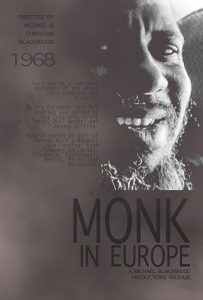 Beasley calls Monk’s “singular musical vision, his crunchy dissonances, open spaces, intervallic jump, off-kilter rhythms, and disjunctive succession of phrases.” Even within Beasley’s readings (which were originally released on the albums MONK’estra Volume 1 and the sequel Volume 2), the band nailed the eccentric, idiosyncratic and frisky sound of the renowned pianist’s compositions.
Beasley calls Monk’s “singular musical vision, his crunchy dissonances, open spaces, intervallic jump, off-kilter rhythms, and disjunctive succession of phrases.” Even within Beasley’s readings (which were originally released on the albums MONK’estra Volume 1 and the sequel Volume 2), the band nailed the eccentric, idiosyncratic and frisky sound of the renowned pianist’s compositions.
So integral is this style to the band that when the fire alarms began to beep and flash in unison, which we thought was part of the act, don’t you know a few members began to improvise beautifully with the strobe lights (but not for long, a voice telling us to remain in our seats interrupted them; oh… there was no fire, and the concert resumed). Monk’s spirit must have been in the Hall because the interruption began in between two numbers — talk about coming in on the downbeat!
Joining the troupe on a few tunes was renowned singer Dee Dee Bridgewater, one of our best jazz vocalists, who not only scatted like a muted trumpet with an improv flair to rival Ella, but sang the hell out of “Ruby, My Dear” (recorded by Monk a few times, including one with John Coltrane in 1957) and, as an encore, “Blue Monk,” proving why his standard has such endurance. A brilliant combination of power, elegance, old soul, young attitude, humor and humility, you can sense that Bridgewater has a spiritual connection to the music. (And I have to boast: When Bridgewater came out during the fire alarm to tell us to remain seated, she wondered why this also happened to her at the airport; I yelled, “It’s because you’re on fire!”)
This concert’s MONK’estra personnel: Trumpets — Bijon Watson, Rashawn Ross, James Ford, Brian Swartz; Trombones — Francisco Torres, Wendell Kelly, Ryan Dragon; Woodwinds — Danny Janklow, Tom Luer, Tommy Peterson, Adam Schroeder, Kristen Edkins; Bass — Ben Shepherd; Drums — Terreon Gully.
The opening set was a program inspired by Errol Garner’s iconic recording, Concert by the Sea, which was reissued as a remastered three-disc boxed set, produced by Jocelyn Arem, Steve Rosenthal, and the great pianist Geri Allen, who sadly passed away last year just after her 60th birthday. On the same day of the CD release in 2015, Allen’s tribute, the Erroll Garner Project: Concert by the Sea, played the Monterey Jazz festival. The re-imagined songs, created for three pianos, bass, drum and guitar, was a hit. The “Three Pianos Tribute” only played one more time before last night in New Orleans. So this encore performance at Disney Hall was as much a tribute to Allen as Garner, who is now gaining a whole new legion of fans because of Ms. Allen’s efforts.
Returning from the original gathering are drummer Victor Lewis (inventive as ever), and bassist Darek Oles (smooth as ever), and guitarist Russell Malone, whose humorous referencing of “You’re Getting to Be a Habit with Me” made his amazing intro to “They Can’t Take That Away from Me” a highlight (aw, hell, everything was a highlight). I’m just sorry we didn’t get even more from pianists Christian Sands (all was right with his “It’s All Right with Me”), Helen Sung (sweet and lovely on “Sweet and Lovely”), and Gerald Clayton, whose “Autumn Leaves” was a mash-up of everything from George Winston to Mr. Monk. We’re ready for your solo concert at Disney Hall, Mr. Clayton.
__________________________________________
photo of concert from Dee Dee Bridgewater’s Facebook page
other photos and video courtesy of LA Phil
Geri Allen’s Errol Garner Project: Concert by the Sea
John Beasley’s MONK’estra
presented by LA Phil
Walt Disney Concert Hall in Los Angeles
played March 9, 2018
for more info, visit John Beasley for tours and LA Phil for future events
